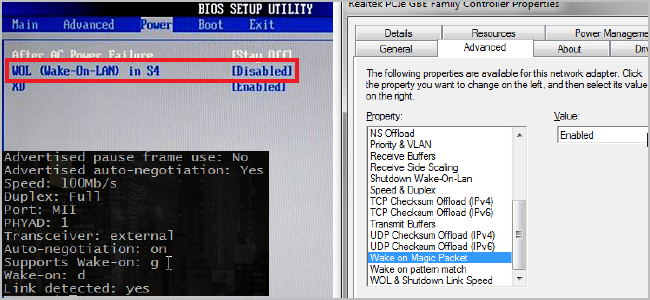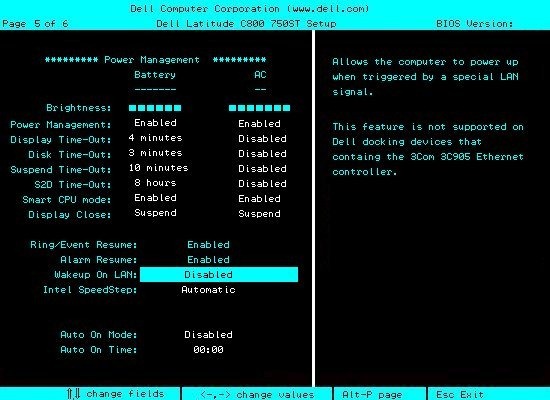
Technology often yields ridiculous conveniences, like being able to turn on your computer from miles away without pushing the power button. Wake-on-LAN, has been around for a while, so let’s see how it works and how we can enable it.

What Is Wake-on-LAN?
Wake-on-LAN is an industry standard protocol for waking computers up from a very low power mode remotely. The definition of “low power mode” has changed a bit over time, but we can take it to mean while the computer is “off” and has access to a power source. The protocol also allows for a supplementary Wake-on-Wireless-LAN ability as well.

WoL is dependent on two things: your motherboard and your network card. Your motherboard must be hooked up to an ATX-compatible power supply, as most computers in the past decade or so are. Your Ethernet or wireless card must also support this functionality. Because it is set either through the BIOS or through your NIC’s firmware, you don’t need specific software to enable it. Support for WoL is pretty universal nowadays, even when it’s not advertised as a feature, so if you have a computer built in the past decade or so you’re covered. If, however, you have a more modern computer, you may find that you have advanced BIOS options for allowing the computer to power on via a time schedule. It’s not technically WoL, but in terms of functionality, it’s pretty close.
For those of you who build your own rigs, take care when buying an Ethernet card. While most built-in cards on motherboards don’t need this step, discrete network cards often need a 3-pin cable attached to the motherboard to support WoL. Do your research online before you buy so you’re not disappointed later on down the line.
The MagicPacket: How WoL Works
WoL-enabled computers essentially wait for a “magic packet” to arrive that includes the NIC’s MAC address in it. These magic packets are sent out by professional software made for any platform, but can also be sent by routers and internet-based websites. The typical ports used for WoL magic packets are UDP 7 and 9. Because your computer is actively listening for a packet, some power is feeding your network card which will result in your laptop’s battery draining faster, so road warriors should take care to turn this off when you need to eke out some extra juice.

Magic packets are usually sent over the entirety of a network and contain the subnet information, network broadcast address, and the MAC address of the target computer’s network card, whether Ethernet or wireless. The above image shows the results of a packet sniffer tool used on magic packet, which brings into question exactly how secure they are when used in unsafe networks and over the internet. On a secure network, or for basic home use, there shouldn’t be any practical reason to worry. Many motherboard manufacturers often implement software along with WoL capabilities to offer hassle-free or largely configuration-free usage scenarios.
Enabling WoL on Your System
BIOS
Most older computers and many modern ones have their WoL settings buried in the BIOS. Depending on your system, you need to hit Escape, F2, or Delete to get into the BIOS, but if you’re not sure then you should check your system’s documentation. Once you’re in, check under Power Management or Advanced Options or something of that sort.

On this HP computer’s BIOS, the setting is found near the “resume after power failure” option.
Many computer, however, do not have a BIOS option. Fortunately, this doesn’t mean that the capability isn’t there, it just means we need to go through the operating system to enable WoL.
Windows
Click Start, then search for and open the Device Manager. Find your networking device in the list.

Right click on it and go to Properties, then click on the Advanced tab.

Scroll down in the list to find “Wake on Magic Packet” and change the Value to “Enabled.” You can leave the other “Wake on” settings alone. Click OK when you’re done.
OS X
Open up your System Settings and choose Energy Saver.

Under the Options tab, you should see “Wake for Ethernet” or something similar. This enables Wake-on-LAN.
Linux
Ubuntu has a great tool that can check to see if your machine supports WoL and can enable it. Open up a terminal and install “ethtool” with the following command:
sudo apt-get install ethtool
You can check your compatibility by running:
sudo ethtool eth0
If your default interface is something else, substitute it for “eth0”.

Look for the “Supports Wake-on” section. As long as one of the letters listed is “g,” you can use magic packets for WoL. To enable this option, use the following command.
sudo ethtool -s eth0 wol g
This should take of it. You can run the command to check and see if it’s enabled now. Look for the “Wake on” section. You should see a “g” instead of a “d” now.

Sending WoL Magic Packets
To send out WoL requests, you have a cornucopia of options available.

Depicus has an excellent series of lightweight tools to get the job done, including a GUI-based one for Windows and command-line-based one for both Windows and Mac OS. Wiki.tcl.tk has a great cross-platform lightweight script that handles the requests as well.
DD-WRT has great WoL support, so if you don’t feel like downloading software to do it, you really don’t have to. Lastly, if you’re out and about, you can use your Android device to wake your computers.
What software do you use to manage and send Wake-on-LAN requests? Do you know of an easier way to enable WoL support? Tell us what you know in the comments!